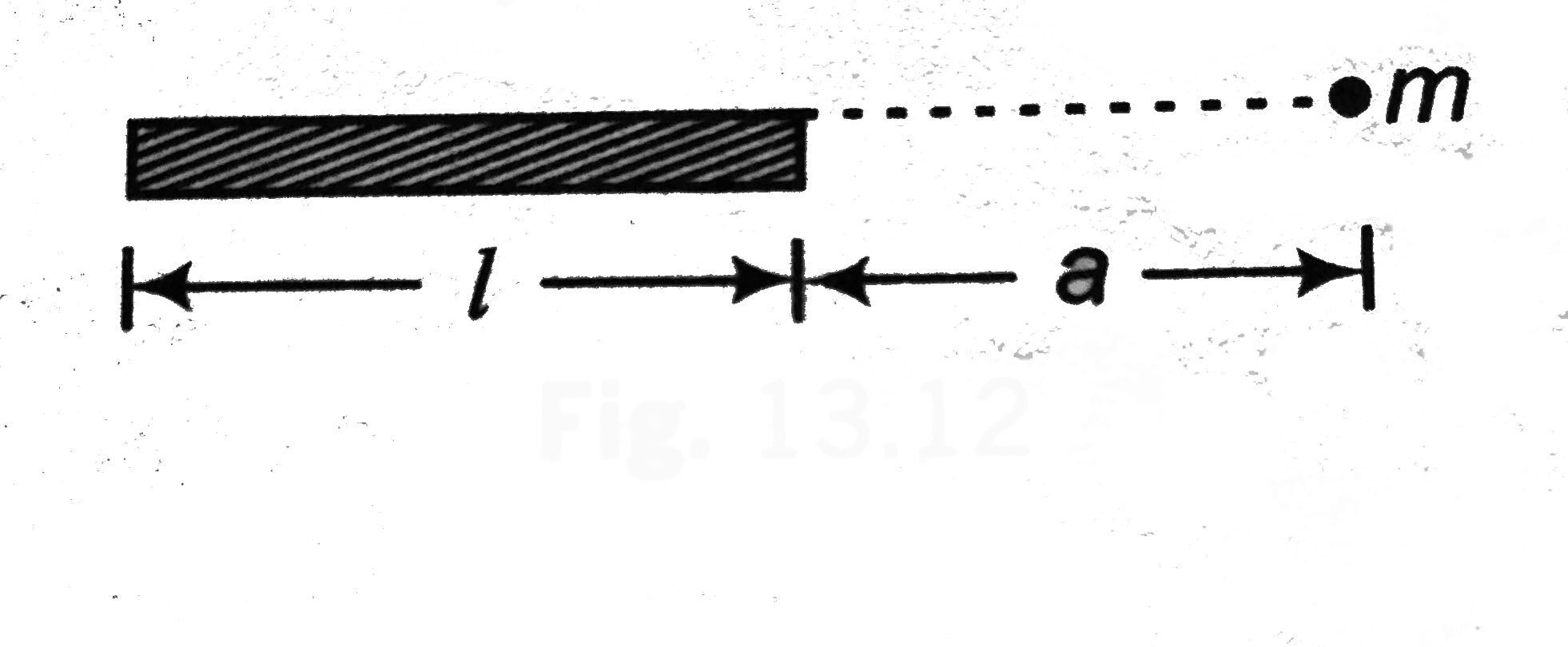A semicircular wire has a length L and mass M. A particle of mass m is placed at the centre of the circle. Find the gravitational attraction on the particle due to the wire.
The correct Answer is:B
To solve the problem of finding the gravitational attraction on a particle of mass m placed at the center of a semicircular wire of length L and mass M, we can follow these steps:
Step 1: Understand the Geometry
The semicircular wire has a radius R. The length of the semicircular wire is given by:
L=πR
From this, we can express the radius R in terms of the length L:
R=Lπ
Step 2: Consider a Small Element of the Wire
Let’s take a small element of the wire of length dx at an angle θ from the vertical. The mass of this small element dm can be expressed as:
dm=ML⋅dx
Step 3: Relate dx to dθ
The length of the small element dx can also be related to the angle dθ as follows:
dx=Rdθ
Thus, substituting for dx gives us:
dm=ML⋅Rdθ
Step 4: Calculate the Gravitational Force
The gravitational force dF between the small element dm and the mass m at the center is given by Newton's law of gravitation:
dF=G⋅dm⋅mR2
Substituting for dm:
dF=G⋅(ML⋅Rdθ)⋅mR2=G⋅M⋅mL⋅Rdθ
Step 5: Resolve the Force into Components
The force dF acts along the line connecting the mass m and the small element dm. We need to consider only the vertical component of this force because the horizontal components will cancel out due to symmetry. The vertical component is given by:
dFy=dF⋅sin(θ)
Thus:
dFy=G⋅M⋅mL⋅R⋅sin(θ)dθ
Step 6: Integrate to Find the Total Force
To find the total gravitational force F on the mass m, we integrate dFy from θ=0 to θ=π:
F=∫π0dFy=∫π0G⋅M⋅mL⋅R⋅sin(θ)dθ
The integral of sin(θ) over 0 to π is 2:
F=G⋅M⋅mL⋅R⋅2
Step 7: Substitute R in Terms of L
Substituting R=Lπ into the expression for F:
F=G⋅M⋅mL⋅Lπ⋅2=2πG⋅M⋅mL2
Final Result
Thus, the gravitational attraction on the particle due to the wire is:
F=2πG⋅M⋅mL2
The semicircular wire has a radius R. The length of the semicircular wire is given by:
L=πR
From this, we can express the radius R in terms of the length L:
R=Lπ
Let’s take a small element of the wire of length dx at an angle θ from the vertical. The mass of this small element dm can be expressed as:
dm=ML⋅dx
The length of the small element dx can also be related to the angle dθ as follows:
dx=Rdθ
Thus, substituting for dx gives us:
dm=ML⋅Rdθ
The gravitational force dF between the small element dm and the mass m at the center is given by Newton's law of gravitation:
dF=G⋅dm⋅mR2
Substituting for dm:
dF=G⋅(ML⋅Rdθ)⋅mR2=G⋅M⋅mL⋅Rdθ
The force dF acts along the line connecting the mass m and the small element dm. We need to consider only the vertical component of this force because the horizontal components will cancel out due to symmetry. The vertical component is given by:
dFy=dF⋅sin(θ)
Thus:
dFy=G⋅M⋅mL⋅R⋅sin(θ)dθ
To find the total gravitational force F on the mass m, we integrate dFy from θ=0 to θ=π:
F=∫π0dFy=∫π0G⋅M⋅mL⋅R⋅sin(θ)dθ
The integral of sin(θ) over 0 to π is 2:
F=G⋅M⋅mL⋅R⋅2
Substituting R=Lπ into the expression for F:
F=G⋅M⋅mL⋅Lπ⋅2=2πG⋅M⋅mL2
Thus, the gravitational attraction on the particle due to the wire is:
F=2πG⋅M⋅mL2
Topper's Solved these Questions
- BOOK - DC PANDEY ENGLISHCHAPTER - GRAVITATIONEXERCISE - Level 2 Single Correct22videos
GRAVITATION
- BOOK - DC PANDEY ENGLISHCHAPTER - GRAVITATIONEXERCISE - Level 2 More Than One Correct10videos
GRAVITATION
- BOOK - DC PANDEY ENGLISHCHAPTER - GRAVITATIONEXERCISE - Level 1 Single Correct27videos
GRAVITATION
- BOOK - DC PANDEY ENGLISHCHAPTER - GENERAL PHYSICSEXERCISE - INTEGER_TYPE2videos
GENERAL PHYSICS
- BOOK - DC PANDEY ENGLISHCHAPTER - KINEMATICSEXERCISE - INTEGER_TYPE10videos
KINEMATICS
Similar Questions
A semicircular wire has a length L and mass M. A particle of mass m is placed at the center of the circle. Find the gravitational attraction on the particle due to the wire.
View SolutionA semicircular wire hs a length L and mass M. A paricle of mass m is placed at the centre of the circle. Find the gravitational attraction on the particle due to the wire.
View Solution
Knowledge Check
- Question 1 - Select One
A particle of mass m is placed at the centre of a unifrom spherical shell of mass 3 m and radius R The gravitational potential on the surface of the shell is .
AGMRB−GMRC−4GMRD−2GMR - Question 2 - Select One
Four particles each of mass m are placed at the vertices of a square of side l. the potential at the centre of square is
A−√2Gm2l(2−1√2)B−2Gm2l(2+1√2)C−√2Gm2l(√2−1√2)D−2Gm2l(√2−1√2)
A semicircular wire has a length L and mass M. A particle of mass m is placed at the centre of the circle. Find the gravitational attraction on the particle due to the wire.
View SolutionA body of mass m is placed at the centre of the spherical shell of radius R and mass M. The gravitation potential on the surface of the shell is
View SolutionFour particles each of mass 'm' are placed at the four vertices of a square 'a' .Find net force on any one the particle.
View SolutionA mass m is at a distance a from one end of a uniform rod of length l and mass M. Find the gravitational force on the mass due to the rod.
 View Solution
View SolutionA particle of mass m is kept on the axis of a fixed circular ring of mass M and radius R at a distance x from the centre of the ring. Find the maximum gravitational force between the ring and the particle.
View SolutionEight particles of mass 'm' each are placed at the verties of a cube of side 'a' . Find gravitational potential energy of this system .
 . View Solution
. View Solution

